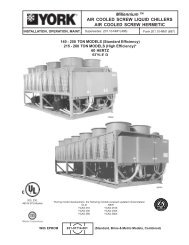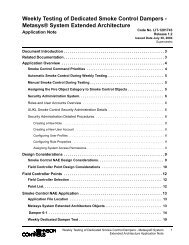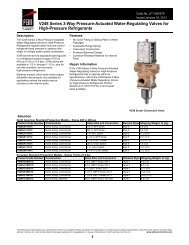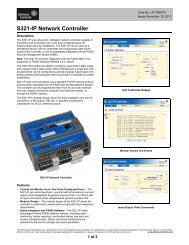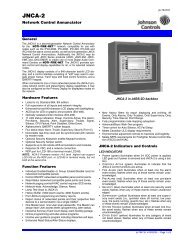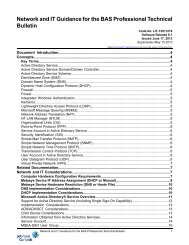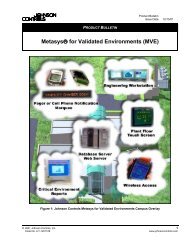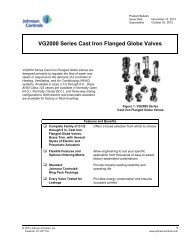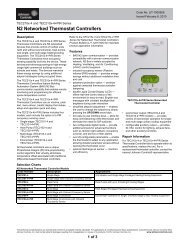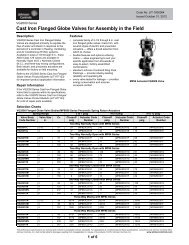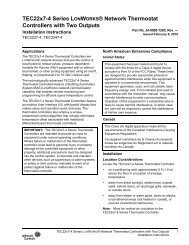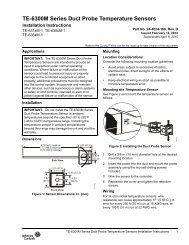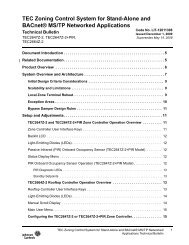YVAA Style A Air-Cooled Screw Liquid Chillers ... - Johnson Controls
YVAA Style A Air-Cooled Screw Liquid Chillers ... - Johnson Controls
YVAA Style A Air-Cooled Screw Liquid Chillers ... - Johnson Controls
Create successful ePaper yourself
Turn your PDF publications into a flip-book with our unique Google optimized e-Paper software.
SECTION 8 - MICROPANEL<br />
XX is the FAULT HISTORY shutdown number. The<br />
display will provide the date, time, and a description of<br />
the specific type of fault that occurred (YYY….).<br />
The operator can view any of the stored 10 fault history<br />
buffers. History buffer number 1 provides the most recent<br />
safety shutdown information and buffer number<br />
10 is the oldest safety shutdown information saved.<br />
The ◄ and ► arrow keys allow scrolling between<br />
each of the FAULT HIST buffers 1 through 10. The ▲<br />
(UP) and ▼ (DOWN) arrow keys can be used to scroll<br />
forwards and backwards through the data in a specific<br />
history buffer, once it is displayed.<br />
There is a large amount of data provided under each<br />
history. Rather than scroll sequentially through the data<br />
in a history, which is possible using the ▼ arrow key,<br />
the use of a combination of the ◄, ►, ▲‚ and ▼ arrow<br />
keys allows fast scrolling to specific data the user<br />
desires to view. To use this feature, the user needs to<br />
be aware the ◄ and ► arrow keys allow scrolling to<br />
the top of the data subgroups. Once a specific history<br />
is selected, the history data is divided under the subgroups<br />
of Unit Data, VSD Data, System Data, Hours/<br />
Starts, Setpoints, Options, and Program data. The ◄<br />
and ► arrow keys allow moving to the first display<br />
under the next or previous subgroup at any time. Once<br />
the first display of a subgroup is displayed, the ▲‚ and<br />
▼ arrow keys allow scrolling though the data in the<br />
subgroup. The ▼ arrow key allows scrolling though<br />
the data from first to last. When the last piece of data<br />
is displayed, the next press of the ▼ arrow key scrolls<br />
to the first piece of data in the next subgroup. The ▲<br />
arrow key allows going to the previous display.<br />
Listed below is a description of the fault data displays<br />
and their meaning. Data will be displayed in a specific<br />
order starting with the Status Display (System Faults<br />
only), Fault Display, All Fault Display, Unit Data, VSD<br />
Data, System Data, Operating Hours/Starts, Setpoints,<br />
Options, and Program Values at the time of the fault.<br />
Status Fault Type<br />
SYS X COMPRESSOR RUNNING<br />
SYS X YYYYYYYY HIGH DIFF OIL PRESSURE<br />
This message indicates the type of system fault. This<br />
screen is skipped if a UNIT Fault caused the shutdown.<br />
106<br />
Unit Fault Type<br />
UNIT FAULT<br />
LOW AMBIENT TEMP<br />
FORM 201.28-NM1.1<br />
ISSUE DATE: 8/29/2012<br />
This message indicates the type of unit fault. This<br />
screen is skipped if a SYSTEM Fault caused the shutdown.<br />
All Fault Data<br />
FAULT HIST XX ALL FAULTS ZZ OF WW<br />
YYYYYYYYYYYYYYYYYYYYYYYYYYYYYYYYYYYYY<br />
The ALL FAULT display indicates whether a fault occurred<br />
while the unit is shutting down on another fault.<br />
If a control panel fault occurred while the unit is shutting<br />
down on a VSD fault before it is reset, the control<br />
panel fault is an ALL FAULT of the VSD fault.<br />
If another VSD fault occurs while the unit is shutting<br />
down on a VSD fault, the next VSD fault will be registered<br />
as an ALL FAULT of the VSD fault.<br />
If a VSD fault occurs during the ramp down shutdown<br />
of a control panel fault, the VSD fault is registered as a<br />
new fault, not an ALL FAULT<br />
XX is the history number, YYY is the ALL FAULT<br />
description, ZZ is the ALL FAULT number and WW<br />
is the total number of All Faults for the current history.<br />
Sometimes, multiple faults may occur during the<br />
shutdown and multiple displays will be observed when<br />
scrolling through the data using the ▼ arrow. In most<br />
cases, the ALL FAULT display will indicate NONE.<br />
The ALL FAULT display will only indicate the cause<br />
of the fault. No additional chiller information will be<br />
displayed under the ALL FAULT, since a snapshot of<br />
all chiller data was taken at the time of the first fault.<br />
Unit Data<br />
Evaporator Leaving and Entering Chilled<br />
<strong>Liquid</strong> Temperatures<br />
UNIT CHILLED LIQUID LEAVING = XXX.X °F<br />
ENTERING = XXX.X °F<br />
This message indicates the leaving and entering chilled<br />
liquid temperatures at the time of the fault.<br />
JOHNSON CONTROLS



